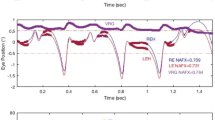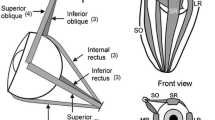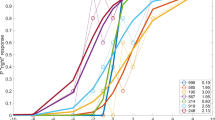Abstract
The vertical eye movements induced by a brief period of free fall were recorded from three monkeys (Macaca mulatta) using the electromagnetic search-coil technique. Free fall was initiated in total darkness immediately following binocular fixation of one of six target lights located at viewing distances ranging from 20 to 107 cm. Responses consisted of an initial transient downward eye movement (anticompensatory direction) with a latency of a few milliseconds at most followed by a sustained upward (compensatory) eye movement. The early transient was independent of viewing distance and attributed to an artifact, whereas the later component was a linear function of the inverse of the prior viewing distance and attributed to the translational vestibulo-ocular reflex (TVOR). Response latencies for the four nearer viewing distances were determined from the individual eye velocity traces using a computerized algorithm: after removing the initial transient by subtracting the mean response obtained with the most distant viewing, a regression line was fitted to the initial rising phase of the residual response and then extrapolated back to the baseline to determine the onset. When so determined, median latencies for the nearest viewing ranged from 16.4 to 18.5 ms, values appreciably shorter than any in the literature.
Similar content being viewed by others
References
Baloh RW, Beykirch K, Honrubia V, Yee RD (1988) Eye movements induced by linear acceleration on a parallel swing. J Neurophysiol 60:2000–2013
Bronstein AM, Gresty MA (1988) Short latency compensatory eye movement responses to transient linear head acceleration: a specific function of the otolith-ocular reflex. Exp Brain Res 71:406–410
Bronstein AM, Gresty MA, Brookes GB (1991) Compensatory otolithic slow phase eye movement responses to abrupt linear head motion in the lateral direction. Acta Otolaryngol (Stockh) [Suppl] 481:42–46
Busettini C, Miles FA, Schwarz U, Carl JR (1994) Human ocular responses to translation of the observer and of the scene: dependence on viewing distance. Exp Brain Res 100:484–494
Bush GA, Miles FA (1994) Ocular compensation during brief periods of free fall. Soc Neurosci Abstr 20:857
Carl JR, Gellman RS (1987) Human smooth pursuit: stimulus-dependent responses. J Neurophysiol 57:1446–1463
Fuchs AF, Robinson DA (1966) A method for measuring horizontal and vertical eye movement chronically in the monkey. J Appl Physiol 21:1068–1070
Gresty MA, Bronstein AM (1986) Otolith stimulation evokes compensatory reflex eye movements of high velocity when linear motion of the head is combined with concurrent angular motion. Neurosci Lett 65:149–154
Gresty MA, Bronstein AM, Barratt H (1987) Eye movement responses to combined linear and angular head movement. Exp Brain Res 65:377–384
Harris LR, Goltz HC, Steinbach MJ (1993) The effect of gravity on the resting position of the cat's eye. Exp Brain Res 96:107–116
Israel I, Berthoz A (1989) Contribution of the otoliths to the calculation of linear displacement. J Neurophysiol 62:247–263
Judge SJ, Richmond BJ, Chu FC (1980) Implantation of magnetic search coils for measurement of eye position: an improved method. Vision Res 20:535–538
Paige GD (1989) The influence of target distance on eye movement responses during vertical linear motion, Exp Brain Res 77:585–593
Paige GD, Tomko D (1991a) Eye movement responses to linear acceleration in the monkey. I. Basic characteristics. J Neurophysiol 65:1170–1182
Paige GD, Tomko DL (1991b) Eye movement responses to linear head motion in the squirrel monkey. II. Visual-vestibular interactions and kinematic considerations. J Neurophysiol 65: 1183–1196
Sanderson AC (1980) Adaptive filtering of neuronal spike train data. IEEE Trans Biomed Eng BME-27:271–274
Schwarz U, Miles FA (1991) Ocular responses to translation and their dependence on viewing distance. I. Motion of the observer. J Neurophysiol 66:851–864
Schwarz U, Busettini C, Miles FA (1989) Ocular responses to linear motion are inversely proportional to viewing distance. Science 245:1394–1396
Skipper JJ, Barnes GR (1989) Eye movements induced by linear acceleration are modified by visualisation of imaginary targets. Acta Otolaryngol (Stockh) [Suppl] 468:289–293
Snyder LH, King WM (1992) Effect of viewing distance and location of the axis of head rotation on the monkey's vestibuloocular reflex. I. Eye movement responses. J Neurophysiol 67: 861–874
Author information
Authors and Affiliations
Rights and permissions
About this article
Cite this article
Bush, G.A., Miles, F.A. Short-latency compensatory eye movements associated with a brief period of free fall. Exp Brain Res 108, 337–340 (1996). https://doi.org/10.1007/BF00228107
Received:
Accepted:
Issue Date:
DOI: https://doi.org/10.1007/BF00228107




